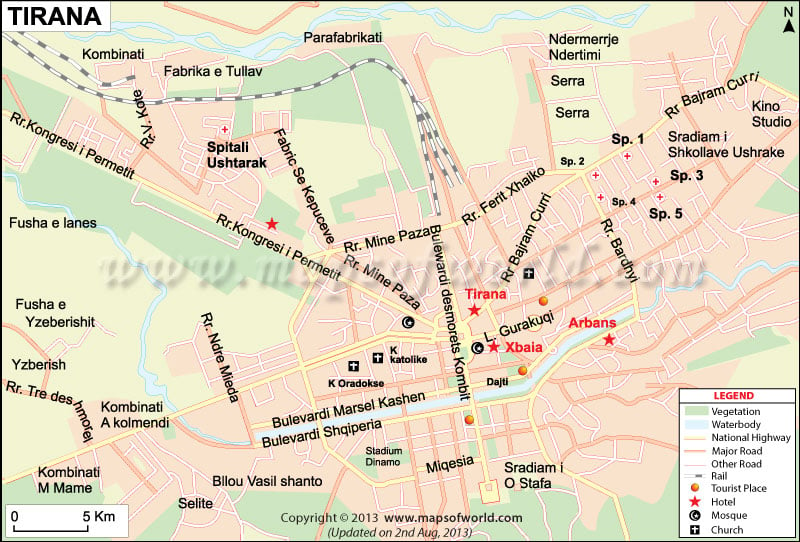About Tirana City :
Tirana is the largest city and the capital of Albania. It is a fascinating city of contrasts and a great place to explore. It covers an area of 41.8 sq kms and had an approximate population of 421,286 in 2011.
The region has been occupied from prehistoric times, but it was in 1614 that Suleiman Pasha Bergjini founded the nucleus of the city with a mosque, a bakery, and a hamam. The town grew in importance as it was located on a caravan route. In 1912, Albania won independence and on 8th February 1920, the Congress of Lushjne proclaimed it to be the temporary capital. On 31st December, 1925, Tirana permanently became the capital. As the city center was designed by Italian architects, the Italian influence is clearly seen in the city.
Geography of Tirana
The city is located in the middle of Albania, about 30 kms away from the coast of the Adriatic. The average altitude of the city is 110 meters above the sea level. Hills and mountains surround the city. The Dajti Mountain lies to the east. A small opening lies to the northwest of the valley which overlooks the Adriatic Sea. A wide plain lies to the northwest. The River Tirana flows through the northern part of the city while the River Lane is another important water body. The city has four artificial lakes. These are Tirana, Tufina, Farka, and Paskuqani.
The city enjoys a Mediterranean type of climate. Summers are hot and dry while winters are cool and wet.
How to reach Tirana (transport) :
You can travel to Tirana by air to the Tirana International Airport Nënë Tereza (Rinas International Airport) which is connected to all major European cities. The airport is located about 17 kms away from the city. You can reach the city by the Rinas Express buses that run from the airport to the Skanderbeg Square.
Trains and buses are best used for domestic transport within Tirana, though the standard of service is not very good. If you are arriving from Italy, you can travel by boat to the port city of Durres and take the train from there to Tirana.
When to visit :
The best time to go to Tirana is from May to October. It is warm and dry and the famous jazz festival is celebrated in July. Winters are cool but generally wet with lots of rain. So, this may not be a good time to explore the city.
Culture (Fairs and Festivals) and Traditions :
Tirana is truly the heart of Albania – the embodiment of all the dreams and aspirations of the country. It is also a city of contrasts with super expensive cars and grand boulevards found side by side with beggars selling replicas of Rolexes and a restaurant that’s a knock-off McDonalds. The diverse culture is best reflected in the festivals of the city:
- The Tirana Jazz Festival began in 2000 and has now become one of the most popular events of the city. Local and international artists are invited to perform so that the audience can enjoy diverse genres of music. The festival is celebrated in July.
- The Tirana Film Festival is a new addition to the events calendar of the city and it is celebrated in October. A number of cutting edge short films are screened – some for the first time – at this event. The event draws a large number of people including local artists to the city.
- Tirana’s autumn is a contemporary music festival held in Tirana at the end of October.
Points of interest (places to visit) :
The important things to see Tirana are as follows :
- The National Museum of History contains a number of archeological treasures dating back 10,000 years. There is also a detailed section on the partisan-communist era.
- The Clock Tower in Skanderbeg Square has become the symbol of the city. Built in the 1820s, it is the oldest construction in the city.
- The Et’hem Bey mosque is one of the most beautiful in Albania with aesthetic decorations and artwork on the inside.
- The Martyrs’ cemetery contains the graves of almost 900 partisans who fought and died during World War II. Many people still visit the graves to pay their respect.
- The National Historic Museum is the main museum in the city and the largest in Albania. A number of archeological treasures, Skanderbeg’s massive sword, icons by Onufri, and a number of other interesting exhibits can help you get a taste of the Tirana culture.
Other places to see in the city include Piramida, National Art Gallery, former residence of Enver Hoxha, Fortress of Justinian, etc.
Accommodation :
For a pleasant stay, you can choose from a number of hotels in Tirana. However, the high rate of taxation tends to make the prices a little steep. The 5-star hotels include Sheraton, while there are a number of 4-star hotels like The Rooms, Brilant Antik, Dinasty Residence, Iliria, Sky Tower, Doro City, Mondial, etc. There are 3-star hotels like Nirvana, Nobel, Rogner, Prince, etc. If you are looking for cheaper accommodations, you can check out the various hostels in the city.
